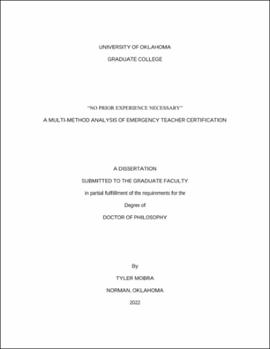| dc.description.abstract | The use of emergency certification for classroom teachers is meant to be a temporary measure that allows school districts to address pressing teaching vacancies in the short term. However, descriptive evidence indicates that the use of emergency certification is rising, and that it has become institutionally entrenched in many states. Given the evidence base indicating the importance of teachers to educational performance, emergency certification raises important questions about who is entering the profession through this pathway, how it influences traditional pathways to the teaching profession, and under what contextual circumstances emergency certification is most likely to be used. This three-paper dissertation explores the association between expanded provisions for emergency certification and enrollments in traditional teacher preparation programs; the contextual circumstances under which emergency certification is used; and the motivations of individuals entering teaching through the emergency certification. In the first paper, analyses show mixed results on the relationship between emergency certification and traditional teacher preparation enrollment. In the second paper, analyses indicate that emergency certified teachers are concentrated in rural and urban school districts. It was also found that emergency certified teachers are more commonly found in early childhood/elementary education, followed by non-core electives. In paper three, in-depth interviews with 30 emergency certified teachers suggested that many emergency certified teachers have a desire to serve youth with special needs, want to help schools in need, and have lifelong aspirations of becoming a teacher. However, individuals also used emergency certification as a contingency employment option, turned to teaching out of financial necessity, and wanted to test out the profession before fully committing to it. Considering the limited literature on emergency certified teachers, these three studies fill key gaps in scholarly knowledge on the use of emergency certification. | en_US |
